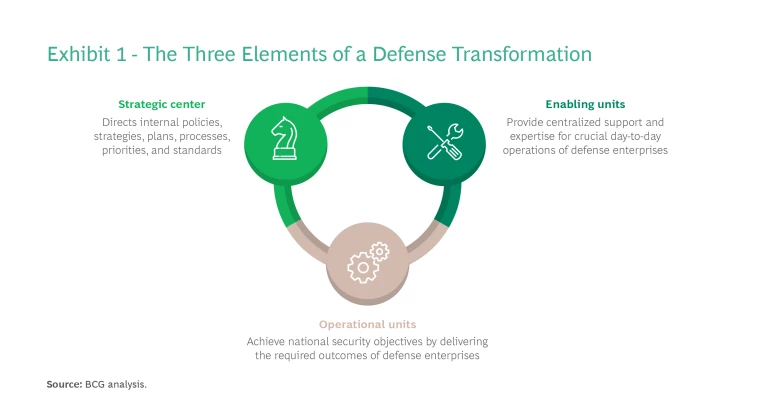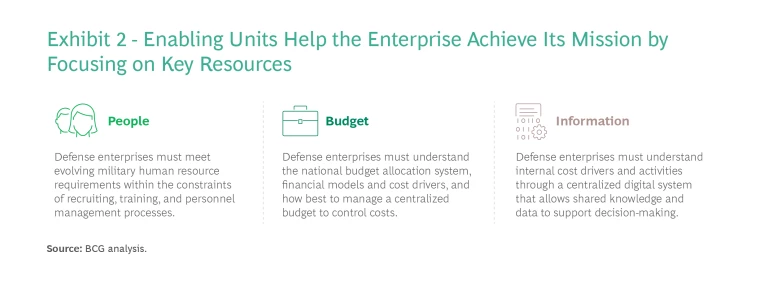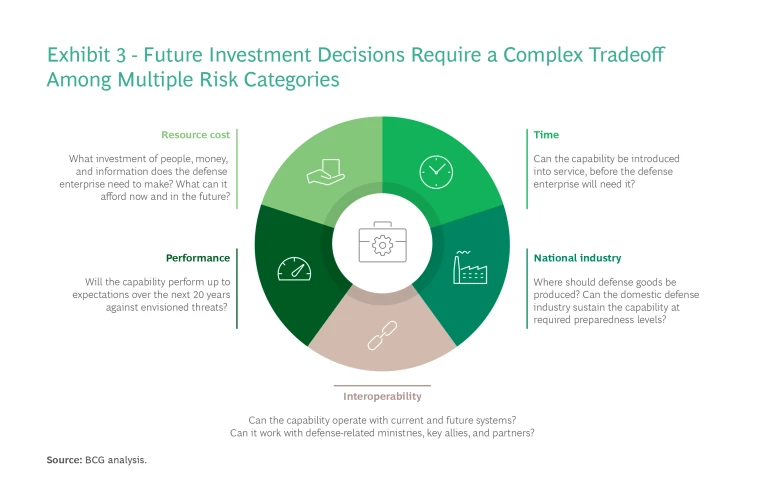Defense organizations need to transform to become more agile and responsive to ever-changing geopolitical risks, technological innovations, and shifting priorities. Old ways of operating do not suffice, yet change can be difficult to implement because defense ministries, national security policy arms, and other related government agencies are often large and bureaucratic.

Based on our experience working with governments around the world, we have identified three critical, mutually supportive elements that all defense enterprises need to deliver on their mission: the strategic center, enabling units, and operational units. (See Exhibit 1.) A common theme across all three is the need to centralize and integrate in order to make defense enterprises more efficient and effective.
The Strategic Center
First, the strategic center develops policies, strategies, and plans to achieve a country’s national security objectives. It must be able to assess the current environment, the country’s current defense and security posture, formulate a long-term vision to counter changes in the environment, and define the investments needed for future requirements. Most defense enterprises have some form of strategic center, but it is often highly decentralized, with multiple units or departments with conflicting authorities, scattered capabilities, and partial information. As a result, decision-making is slow and ineffective.
To improve, a defense enterprise transformation needs to focus on centralizing all strategic and policy capabilities into a single, well-integrated unit with the following capabilities.
- Shape all national defense and security policy. Most important, the strategic center is tasked with developing all defense policy, factoring international engagement, financial and fiscal policy, and other diplomatic, informational, military, and economic priorities. It then needs to translate and direct these considerations throughout the rest of the defense enterprise and partner with other government agencies on implementation.
- Assess future defense requirements. The strategic center must also collaborate closely with the operating units to conduct planning that links the current service structure and posture to future requirements based on assessments of threats, opportunities, international partners, and the required resources. Further, it prioritizes capabilities within the constraints of available resources to best address identified threats.
- Anticipate and manage risks. The strategic center must possess strategic foresight to proactively anticipate, mitigate, and manage defense and security risks as well as risks to defense policies, processes, and other internal points of vulnerability.
A foundational aspect of all these capabilities is effective governance. The strategic center must have a strong decision-making structure, with minimal bureaucracy and clear lines of authority that ensure decisions get made at the right level—as close to the point of action as possible, by people with the right level of expertise who have access to all required information. Further, effective governance should ensure accountability for implementation as well. Successful defense enterprises implement a measurable performance management system that enables them to monitor progress over time, course correct as needed, and remain accountable for results.
Decision-making governance should strive to achieve good alignment between strategy and policy development as well as required outcomes. It should drive decisions at appropriate levels of the organization, leverage boards or committees sparsely and strategically to avoid burdensome bureaucracy, and ensure reliable access to common information.
Enabling Units
The second major component of a defense enterprise are enabling units, which provide the day-to-day services that enable the enterprise to fill its role in meeting national security objectives. These enterprise services are focused on three key resources: people, budget, and information. (See Exhibit 2.) Each needs its own high-functioning capabilities.

As with the strategic center, the enabling units at many defense enterprises are highly decentralized, which leads to inefficiency and incoherent policies and programs. All enabling units do not need to be centralized—some can be more effective when handled at a more local level—but all need to be streamlined to improve outcomes, clarify decisions, reduce inefficiencies, and improve the quality of services.
People. The most valuable resource within the defense enterprise and the means by which a country can achieve its defense and security objectives is its people. To respond to the current and future security environment, defense enterprises must address HR requirements and make recruiting, training, and personnel management more responsive. This means building a modern, strategic human capital function. Such a function can integrate uniformed personnel, government employees, and contractors across the defense enterprise to provide the right quality person for a given job, at the right time, with the right skills. Governments must develop the capability to forecast and plan for future work force requirements, including numbers, education, skills, remuneration, and other factors.
Budget. Fundamental to a defense enterprise is the judicious use of funds to maximize value and outcomes for every dollar spent. Understanding cost drivers helps identify waste, along with resources that can be reallocated to yield better results. Forward-looking budgets are also critical to modeling the costs and benefits of potential changes to the organization’s policies, processes, or objectives—a key assessment in any transformation. Broadly, most budget functions of defense enterprises must be centralized to some degree to accomplish these objectives.
In addition, defense enterprises need to understand the national budget allocation system and whether it will enable, or hinder, a defense enterprise transformation. In some instances, defense enterprises receive an allocated budget to cover basic investment and maintenance costs, with a supplemental budget allocation approved by the government for conducting operations. In other cases, the defense enterprise’s operational budget is included, with operational outcomes considered part of daily business (for example, police or fire brigades). Defense-related enterprises tend to have these budget elements separated. In all cases, the defense enterprise must have a clear understanding of the financial model, and how that model might change as part of a transformation.
Information. Among the most critical resources for defense enterprises is information. This includes strong digital and technological infrastructure as well as robust data-driven decision-making systems empowered by artificial intelligence. To operate effectively, defense enterprises need to develop an enterprise-wide understanding of the business: how it operates, how it is spending financial resources, how it is performing, and which decisions need to be made—and when—for optimal performance.
Some defense organizations operate multiple, function-specific enterprise resource planning systems that do not link to each other, leading to information silos and disjointed decisions. Conversely, integrated digital platforms can provide a single source of truth and enable real-time situational awareness across strategic leadership, combat, and non-combat units. As a result, decisions can happen faster, and all stakeholders share a common—and accurate—understanding of performance.
The key is to integrate as many systems as possible, across all functional business lines, and minimize the number of standalone systems. Any defense enterprise transformation should include the development of a digital backbone with clear and robust technical, security, and data management processes. Deployed IT systems can support core business units, with the right level of interoperability with the central system.
In addition to increased transparency and more effective decision-making, integrating IT systems leads to smarter data protection, along with cost advantages. Defense enterprises that invest in adaptable systems that can grow with them save long-term costs across the enterprise in areas including software and hardware management, data storage and security, support systems (such as logistics and maintenance), and training.
Operational Units
Operational units marshal available resources to deliver required outcomes and achieve national security objectives. They undertake missions including physical deployment to the field. To support operational units, defense enterprises need superior short- and long-term planning, budgeting, procurement, and logistical capabilities.
Operating units used to work as independent services, but they need to become more interoperable. Wherever possible, a single, integrated joint force design leads to better outcomes. This approach ensures that the various services train and can operate together and, when required, can seamlessly collaborate to achieve national security objectives. Creating a successful joint force involves the removal of non-core or redundant organizations and processes as well as aligning organizational structures and decision-making to support interoperability.
Defense entities typically have two objectives in transforming operational units. The first is to align them with broader transformations underway across the entire enterprise. The second is within the unit itself, to improve processes, integrate operational concepts and doctrine, and command and control organizations to make more effective decisions. Leaders first establish a baseline for how a unit currently delivers its intended outcome, and then determine where there may be more effective and efficient ways to structure and operate the unit to improve outcomes (or, in some cases, maintain current outcomes with fewer resources).
Forecasting the Future
Transforming defense enterprises from their current state—typically a collection of federated organizations—into agile, resource informed, integrated enterprises is a challenge. Preparing them for not just today’s tests but tomorrow’s adds an additional layer of complexity. The strategic center will therefore need to make value judgments regarding future investment decisions.

Strong strategic center organizations forecast future requirements and calculate the impact and risks of delivering government policy objectives across multiple scenarios. They must be able to forecast the operational and enabling structures and collected capabilities needed for success. This includes understanding the costs and benefits of proposed capability improvements, whether they are achievable with forecasted resources, and their potential effectiveness under future threat scenarios.
This strategy-led, resource-informed process—“force by design”—is key to understanding what the defense enterprise needs to invest in for the future. It also entails making informed tradeoffs among multiple risks. (See Exhibit 3.) The interplay of tradeoffs requires tight integration of activity among all elements of the defense enterprise during the force design process.
Many defense enterprises are still relatively fragmented, bureaucratic, and inefficient, but with the right approach, they can become nimble, fast-moving, and fit for purpose. The strategic center, enabling units, and operational units are the key considerations required for a successful defense enterprise transformation.
The authors are grateful to Matt Schlueter and Troy Thomas for their contributions to this article.












